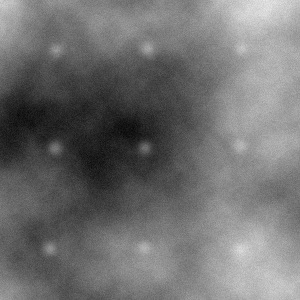Answer the question
In order to leave comments, you need to log in
What is the way to detect an object with given parameters against a strongly correlated background?
The situation is this. There is an image consisting of a strongly correlated texture, on which there is an object with known parameters, including the shape and the fact that its intensity is always greater than the intensity of the underlying background. Additionally, white noise with approximately known dispersion was superimposed on this image.
To make it clearer what all this is, an example of such an image is attached below: 
The objects here are 9 circles arranged on a grid.
The goal is to suppress noise and background so as to reduce the background dispersion as much as possible, and then increase the intensity of the object to increase the signal-to-noise ratio (the ratio of the contrast of the object to the standard deviation of the background).
Answer the question
In order to leave comments, you need to log in
Noise, if its mathematical expectation is equal to 0 and there are no regularities, cannot be removed. Its maximum influence can be weakened by smoothing, but its parameters must be controlled so that it does not have an excessive negative impact on the quality of recognition in the future.
The background, judging by your illustration, it seems to me possible to estimate (interpolate) for each pixel by N image points by some algorithm that is resistant to the presence of the desired objects (i.e., based on the hypothesis that the desired objects are sufficiently removed from each other and their known size, the relative position of the points for calculating the interpolation must be chosen so that it could not simultaneously belong to the desired object more than K points). Offhand (N=9, K=1) for a 3x3 matrix with a side length slightly greater than twice the diameter of the desired circle (interpolation should not be performed for the entire 3x3 matrix, but only for the central region of 0.5x0.5).
Didn't find what you were looking for?
Ask your questionAsk a Question
731 491 924 answers to any question